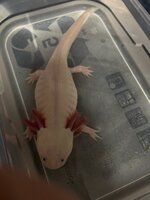Joshyschendel
New member
- Joined
- Oct 14, 2023
- Messages
- 5
- Reaction score
- 1
- Points
- 3
- Location
- Rochester, MN
- Country
- United States
My axie is around 2 years old, and for the past 4 days has been refusing food, sometimes puking up what appears to look like his pellets after he digests and poops them out. For most of the day he is walking back and forth the entire length of my 30gal tank and then swimming up and gulping air. I noticed his tail might be floating lightly higher than his front so I assumed he was constipated. I have just moved him into a tub on the floor today so he doesn’t have to swim high up for ait, and attempted to feed him again, with no luck.
He otherwise looks overall normal, just constantly has vibrant gills and is active. Any advice on what could be going on? I’m looking into finding a vet nearby but I know that if he is sick, potentially waiting til I get into a vet would be too long.
I did test the water parameter and they are as followed
Chlorine 0
Ammonia 0
Nitrite 0
Nitrate 25
Attached is a photo of him after tubbing him (he only starting curling his tail after tubbing.
He otherwise looks overall normal, just constantly has vibrant gills and is active. Any advice on what could be going on? I’m looking into finding a vet nearby but I know that if he is sick, potentially waiting til I get into a vet would be too long.
I did test the water parameter and they are as followed
Chlorine 0
Ammonia 0
Nitrite 0
Nitrate 25
Attached is a photo of him after tubbing him (he only starting curling his tail after tubbing.

